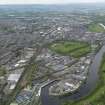Pricing Change
New pricing for orders of material from this site will come into place shortly. Charges for supply of digital images, digitisation on demand, prints and licensing will be altered.
Perth Harbour
Harbour (Period Unassigned)
Site Name Perth Harbour
Classification Harbour (Period Unassigned)
Alternative Name(s) River Tay; Friarton Quay; Friarton Harbour
Canmore ID 28368
Site Number NO12SW 202
NGR NO 1188 2195
NGR Description Centred NO 1188 2195
Datum OSGB36 - NGR
Permalink http://canmore.org.uk/site/28368
- Council Perth And Kinross
- Parish Perth
- Former Region Tayside
- Former District Perth And Kinross
- Former County Perthshire
NO12SW 202 centred 1188 2195
Location formerly cited as NO 11 21 to NO 12 22.
For discovery of harbour works during excavations at Tay Street, Baptist Church site (NO 1204 2333), see NO 12SW 145.
For original harbour at Perth, see NO12SW 1142.
Perth Harbour [NAT] (at NO 1188 2195)
OS 1:10,000 map, 1994.
(Location cited as NO 118 219). Perth Harbour. Rebuilt from 1830. A small, roughly rectangular tidal basin off the River Tay, now concrete-faced, and a quayed stretch of the river bank.
J R Hume 1977.
There is documentary evidence for three harbours at Perth. The earliest (NO12SW 1142) is indicated on the earliest (1715) map of Perth and was probably the original harbour founded by David I, just before 1127. Situated adjacent to the former bridge NO12SW 77 and at the eastern end of the High Street, [at NO c. 1207 2366], it has not been the subject of controlled excavation, but underpinning work beneath the council chambers (NO12SW 125) has revealed timber structures nearly 5m below street level.
The second harbour (NO12SW 145) or New Haven is dated to 1539, when the Perth Guildry Book records that John Moncur of Balluny paid for the carriage of 200 ashlar stones for its construction. This harbour also appears on Louis Pettit's map of 1715 up against the Greyfriars' burial ground (NO12SW 204) at the SE corner of the town and at the outflow of the southern branch of the town lade (NO12SW 50), which now runs beneath Canal Street. This harbour was formed by opening up the mouth of the southern lade into a large basin and building stone quay (the 'Coal Shore') on the S side of the basin, under the walls of Greyfriars. The canal was covered-over by about 1806 and the basin subsequently infilled, as is indicated by the 1st edition of the OS Map (1862/3). Ships could still be berthed along the waterfront until the 1870's, when the foreshore was embanked to form Tay Street.
The third harbour (NO12SW 202) at Friarton (about a mile down river) superseded the other two in the 19th century.
D P Bowler 1991.
This small open harbour is situated on the W side of the W channel of the River Tay, opposite the S end of Friarton or Moncreffe Island and to the SE of the town of Perth (NO12SW 100). It is formed of two open quays, and has no enclosing works.
Information from RCAHMS (RJCM), 31 May 2006.
Project (2007)
This project was undertaken to input site information listed in 'Civil engineering heritage: Scotland - Lowlands and Borders' by R Paxton and J Shipway, 2007.
Publication Account (2007)
The Tay has been navigated up to Perth by small boats from at least as early as 1147 with the harbour, consisting of quays along the west shore, in existence for centuries. The modern harbour, opposite Moncreiffe Island, was originally planned by Robert and Alan Stevenson in 1833 with larger quays and a dock at an estimated cost of £48 714.
After a delay the developed scheme, then estimated to cost more than £50 000, was to have been completed by 1854 but in that year the Harbour Commissioners went bankrupt with the work only partly done. The harbour
and its debts were taken over by Perth Council but the work remained unfinished for a long time.
The Stevensons also directed a significant improvement of the Tay navigation channel by the removal of fords. By 1841 the water depth at spring tides had been increased from 1134 ft to 16 ft and vessels drawing 14 ft were able to reach Perth in one tide ‘with ease and safety’.
Much of the harbour walling was of timber which has gradually been replaced with steel-sheet piling. Harbour improvements costing £30 000 were carried out in 1955– 56.
R Paxton and J Shipway
Reproduced from 'Civil Engineering heritage: Scotland - Lowlands and Borders' with kind permission of Thomas Telford Publishers.




































